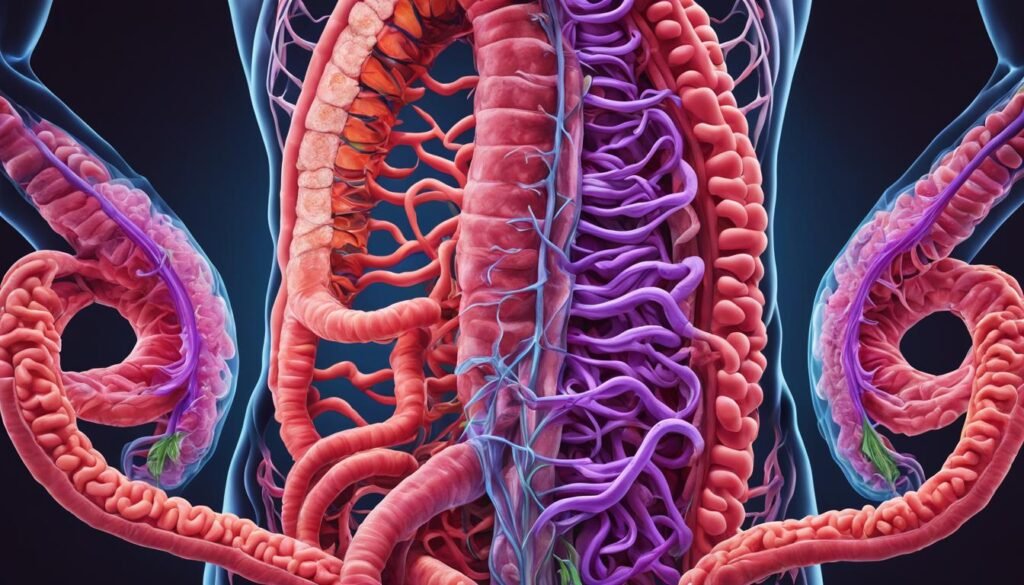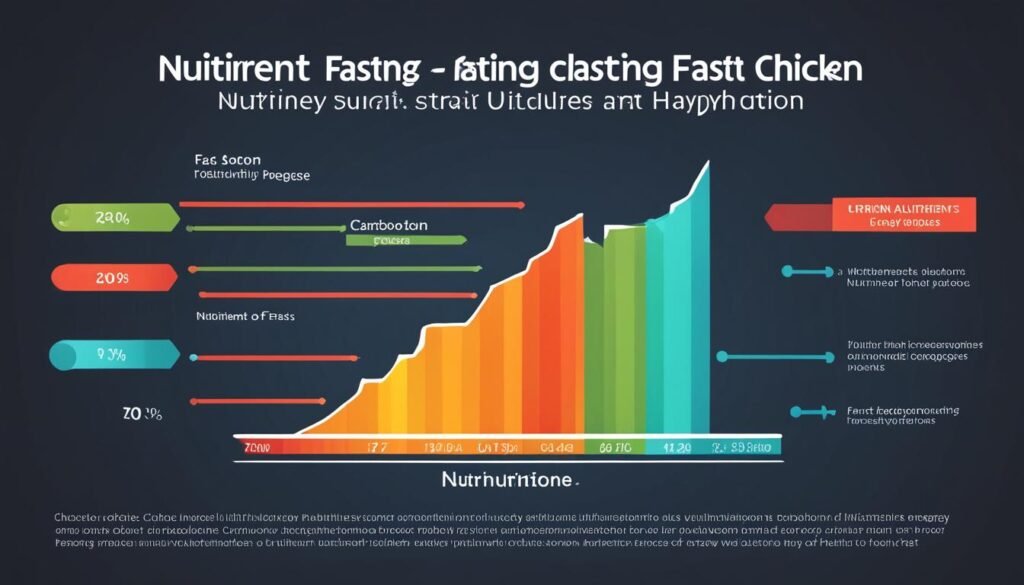Have you ever wondered how long a chicken can go without food? The duration of chicken fasting periods is an important factor in poultry production and care. In this article, we will explore the chicken fasting period, how many days a chicken can survive without eating, and the importance of regular feeding schedules for chickens.
Feeding chickens regularly is essential for their health and well-being. Just like humans, chickens require a consistent food intake to fulfill their nutritional needs and maintain optimal body functions. A well-planned feeding schedule ensures that chickens receive the necessary nutrients for growth, egg production, and overall health.
However, there are instances when chickens need to fast. Fasting is a common practice in the poultry industry to empty the gastrointestinal tract before processing and to assess the energy efficiency of feed ingredients. The fasting period for broiler chickens is typically 6 to 12 hours, while adult roosters may require 24 hours or more.
It is important to note that shorter fasting periods can increase the risks of carcass contamination and reduce meat quality. Fasting also affects the glycogen concentration in the muscles, which can impact meat pH and the incidence of pale, soft, exudative (PSE) meat. To maintain meat quality during fasting, water spray during lairage has been found to be beneficial, but it can also affect meat quality in other ways, such as increased cooking loss and reduced water retention capacity.
Understanding the relationship between fasting duration and meat quality is crucial for the poultry industry. Additionally, fasting has been found to activate autophagy in the chicken intestine, a cellular process that helps maintain gut homeostasis and regulates cell growth. Further research is needed to fully grasp the implications of fasting on intestinal autophagy and gut health.
In conclusion, learning about chicken fasting durations is essential for ensuring the well-being and productivity of chickens. By understanding the optimal fasting periods, we can improve meat quality, maintain intestinal health, and optimize energy and nutrient utilization for different age groups of chickens.
Determining the Effects of Fasting on Meat Quality
Fasting periods have a significant impact on the quality of meat produced from chickens. Various factors, such as meat luminosity, pH values, drip loss, cooking loss, shear force, and meat color, are influenced by the duration of fasting.
Meat Luminosity: The luminosity of meat refers to its brightness or shininess. Research has shown that meat luminosity is highest after a fasting period of 4 hours. However, longer fasting periods do not show significant differences in meat luminosity.
Meat pH Values: pH values in meat can affect its quality and characteristics. When chickens receive water spray during fasting, the meat pH values tend to be lower. This indicates a more acidic meat, which can have implications for flavor and texture.
Drip Loss and Cooking Loss: Fasting duration also plays a role in the amount of drip loss and cooking loss experienced during meat processing. Longer fasting periods have been found to result in higher levels of both drip loss and cooking loss. This means that more moisture is lost during cooking and processing, which can affect the tenderness and juiciness of the meat.
Shear Force: Shear force is a measure of meat tenderness, indicating the force required to cut through the meat. Fasting has been found to influence shear force, although the relationship is not as clear. Further research is needed to understand the specific effects of fasting on meat tenderness.
Overall, it is important to note that very short fasting periods, less than 4 hours, can have a negative impact on meat quality. Balancing the fasting period with other factors, such as water spray during fasting, can help optimize meat quality.
Effects of Fasting on Meat Quality:
| Meat Quality Aspect | Effect of Fasting Period |
|---|---|
| Meat Luminosity | Highest after a 4-hour fasting period |
| Meat pH Values | Lower when birds receive water spray during fasting |
| Drip Loss and Cooking Loss | Higher levels with longer fasting periods |
| Shear Force | Effects not yet fully understood |
The Relationship Between Fasting and Intestinal Autophagy
Fasting plays a significant role in activating autophagy in the intestine, a cellular process that maintains gut homeostasis and regulates cell growth. During fasting, autophagy is triggered to scavenge cytoplasmic materials for energy production, ensuring the body’s survival when food is scarce.
Autophagy is crucial for gut health as it eliminates damaged organelles and intracellular pathogens, preventing their accumulation and promoting the overall well-being of the intestinal cells. Proper autophagy function helps maintain intestinal integrity and function.
Anomalous autophagy has been linked to various gastrointestinal disorders, such as inflammatory bowel diseases and impaired absorptive enterocytes. Dysregulated autophagy disrupts the balance within the gut, leading to inflammation and compromised gut health.
Studies have shown that the duration of fasting can influence the level of autophagy in the intestine. However, in the case of chicken, the specific relationship between fasting duration and autophagy remains unknown. Further research is necessary to comprehensively understand how variations in fasting duration impact intestinal autophagy and its implications for gut health in chickens.

Effects of Fasting on Intestinal Autophagy
| Fasting Duration | Level of Intestinal Autophagy |
|---|---|
| Short Duration (e.g., 12 hours) | Unknown |
| Intermediate Duration (e.g., 24 hours) | Unknown |
| Long Duration (e.g., 48 hours or more) | Unknown |
The presented table illustrates the current gap in knowledge regarding the specific relationship between fasting duration and intestinal autophagy in chickens. It highlights that the effects of different fasting durations on autophagy levels are yet to be determined. Further research is necessary to fill these knowledge gaps and provide insights into how fasting influences gut health in chickens.
Impact of Fasting on Energy and Nutrient Utilization
Fasting has a significant impact on energy and nutrient utilization in chickens. Research has shown that fasting duration plays a key role in determining how efficiently chickens utilize energy and nutrients, with variations observed between broilers and adult roosters.
In broilers, shorter fasting periods, typically less than 12 hours, have been found to increase the total tract digestibility of metabolizable energy, gross energy, and ether extract. This means that chickens are able to extract and absorb more energy and nutrients from their feed when they are subjected to shorter fasting periods.
However, fasting also has a negative effect on nutrient utilization in broilers. Longer fasting periods result in decreased total tract digestibility of nitrogen, which means that chickens are not able to effectively utilize dietary protein. This can have implications for their overall growth and development.
Interestingly, the impact of fasting on energy and nutrient utilization differs in adult roosters. Fasting actually increases the total tract digestibility of nitrogen in adult roosters, indicating that they may have a different metabolic response to fasting compared to broilers.
Note: It’s important to note that the total tract digestibility calculated using the total collection method may be overestimated when compared to the index method. Therefore, caution should be exercised when interpreting and comparing digestive efficiency data.
To fully understand the effects of fasting on energy and nutrient utilization in different age groups of chickens, further research is needed. This will help optimize fasting durations and feeding practices to ensure optimal energy utilization, nutrient utilization, and overall productivity in poultry production.

Table: Differences in energy and nutrient utilization between broilers and adult roosters
| Fasting Duration | Broilers | Adult Roosters |
|---|---|---|
| Shorter (less than 12 hours) | Increased total tract digestibility of metabolizable energy, gross energy, and ether extract | No significant data available |
| Longer (more than 12 hours) | Decreased total tract digestibility of nitrogen | Increased total tract digestibility of nitrogen |
Conclusion
Understanding the optimal chicken fasting durations is crucial for ensuring the welfare and quality of poultry meat. Fasting not only affects meat quality but also activates important cellular processes in the chicken intestine, such as autophagy, which play critical roles in maintaining intestinal homeostasis and gut health.
In terms of meat quality, shorter fasting periods have been found to result in better luminosity and pH values, indicating higher meat quality. However, longer fasting periods can lead to increased drip loss and cooking loss, which may negatively impact the overall quality of the meat.
Furthermore, fasting has been shown to activate autophagy in the intestine, which helps to regulate cell growth and maintain gut health. The duration of fasting can influence the level of autophagy, but further research is required to fully understand the relationship between fasting duration and intestinal autophagy in chickens.
Additionally, fasting has implications for energy and nutrient utilization in chickens. There are differences observed between broilers and adult roosters, and further research is needed to fully understand how fasting affects energy and nutrient utilization in different age groups of chickens.
Overall, optimizing fasting durations and providing regular feed schedules are essential for ensuring the well-being, productivity, and quality of chickens. Further research in these areas will continue to shed light on the best practices for chicken fasting durations and their impact on meat quality, intestinal autophagy, energy utilization, and nutrient utilization.





